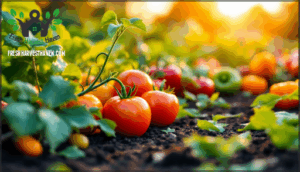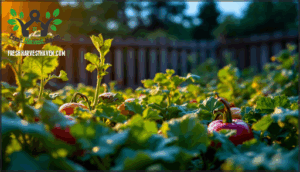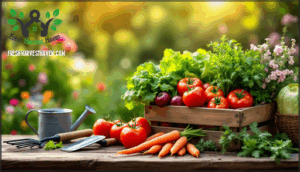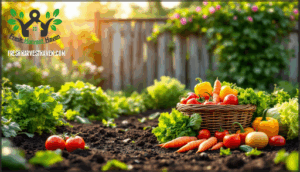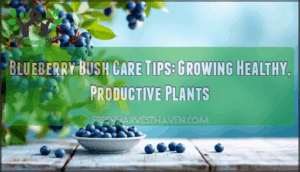This site is supported by our readers. We may earn a commission, at no cost to you, if you purchase through links.
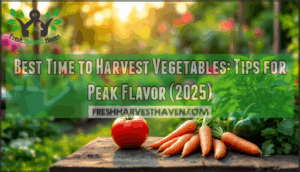
Temperature, light, and moisture all shift the window when vegetables hit their peak, and what worked last summer might not work this year. Learning to read the signs your plants send you transforms guessing into genuine skill.
Once you know what to look for in color, texture, and timing, you’ll consistently pull vegetables at their absolute best.
Table Of Contents
Key Takeaways
- Harvest timing depends on multiple shifting factors—climate, soil health, variety maturity dates, and day length—rather than fixed calendar dates, so learning to read visual cues like color, texture, and sheen gives you consistent results.
- Early morning harvesting after dew dries locks in peak flavor and crispness because plants are fully hydrated from the cool night, while midday or evening picks lead to wilted, heat-stressed produce vulnerable to disease.
- Each vegetable type requires specific harvesting techniques—leafy greens benefit from outer-leaf picking to extend production, root crops need gentle soil loosening, and fruiting vegetables like tomatoes and peppers should be twisted at stem joints rather than yanked.
- Frequent harvesting actually boosts yields for many crops by signaling plants to keep producing, and proper post-harvest care means cooling produce quickly, avoiding immediate washing to prevent mold, and storing at correct humidity levels to maximize shelf life.
Key Factors Affecting Vegetable Harvest Timing
Getting the harvest timing right isn’t just about counting days on a calendar. Several moving pieces work together to tell you when your vegetables hit their peak.
Let’s look at the main factors that’ll help you decide when it’s time to start picking.
Climate and Weather Conditions
When Mother Nature shifts gears—whether she’s cranking up the heat or dropping an unexpected frost—your vegetables feel it first, and their harvest timeline changes right along with her. Temperature fluctuations can speed up or slow down ripening, while rainfall patterns affect flavor intensity.
Check your climate zone and use weather forecasting to time your harvest for peak flavor. Smart gardeners practice frost protection and adjust crop management based on what’s coming.
Soil Fertility and Plant Health
Your soil’s nutrient levels don’t just feed your plants—they control how fast your vegetables grow, how they taste, and ultimately when you should harvest them. Healthy soil packed with compost benefits and proper nutrient cycling keeps your crops on schedule, while depleted ground delays maturity and dulls flavor.
Build better soil through smart gardening and crop management:
- Soil testing reveals exactly what fertilizer types you need
- Crop rotation prevents nutrient depletion and disease buildup
- Regular composting improves plant care through natural soil science
Strong plants hit their harvest window right on time.
Vegetable Variety and Maturity Dates
Beyond soil health, seed selection matters immensely. Different varieties of the same vegetable can mature weeks apart. Bush beans range from 46 to 70 days, while cabbage spans 52 to 110 days depending on variety choice. Check your seed packet’s maturity dates for crop planning—but remember, those numbers shift based on your local conditions.
Here’s how common vegetables vary:
| Vegetable | Fast Variety | Standard Variety | Late Variety |
|---|---|---|---|
| Carrots | 50 days (Baby Finger) | 70 days (Scarlet Nantes) | 85 days |
| Tomatoes | 55 days | 70 days | 90 days |
| Cabbage | 52 days (Charmant) | 75 days | 110 days |
| Bok Choy | 30 days | 37 days | 45 days |
| Bush Beans | 46 days | 58 days | 70 days |
Choosing early-maturing varieties gives you flexibility with harvest timing and allows multiple plantings per season. Understanding fast growing crops is essential for optimizing your garden’s yield.
Day Length and Light Exposure
Light plays a bigger role in harvest timing than most gardeners realize—some vegetables won’t ripen properly without the right amount of daylight, while others race to bolt when days stretch too long. Photoperiod effects govern when spinach flowers or tomatoes set fruit.
Day length triggers hormonal changes that affect peak flavor. Managing solar exposure and shade helps you control harvest timing—especially for crops sensitive to light intensity shifts throughout the growing season.
Identifying Vegetable Ripeness in The Garden
Knowing when your vegetables are ready to pick isn’t guesswork—it’s about reading the signs your plants give you. A few simple visual and physical cues can tell you if that tomato or cucumber has reached its peak.
Let’s look at the key indicators that help you harvest at just the right moment.
Color, Size, and Sheen as Indicators
When you spot a tomato blushing red or a pepper gleaming like polished glass, you’re seeing nature’s way of telling you it’s time to pick. Here’s what to watch for when checking ripeness:
- Color change signals peak flavor—deep hues mean sugars have developed
- Size variation matters; most vegetables reach harvest timing at their listed mature dimensions
- Sheen factors reveal freshness—glossy surfaces indicate proper ripeness
- Texture checks confirm readiness; firm yet slightly yielding produce is perfect for vegetable harvesting
Flavor, Aroma, and Texture Checks
Your taste buds and nose are actually your most reliable harvest guides—sometimes even better than what your eyes can tell you. A quick aroma test near the stem end tells you if those melons are ready—sweetness should hit you right away.
Your nose and taste buds often reveal ripeness better than your eyes—smell the stem end for sweetness to know when melons are ready
For texture analysis, gently squeeze to check firmness without bruising. That slight give in a ripe tomato or the snap of a fresh bean pod confirms perfect harvest timing. Trust your sensory evaluation for peak flavor every time.
Common Signs of Overripe Produce
Missing the harvest window can turn your prize vegetables into compost candidates. Overripe symptoms include fruit softening beyond that ideal gentle give, vegetable wilting even when watered, and dull color changes instead of vibrant hues. Ethylene production accelerates in overripe produce, triggering faster decay.
Catch harvest timing right before split skins, mushy spots, or that unmistakable fermented smell appear—your nose knows when peak flavor has passed. Understanding the role of ethylene gas production is vital for ideal harvest timing.
Best Times of Day to Harvest Vegetables
When you pick your vegetables matters just as much as knowing they’re ripe. The clock and the weather work together to affect how crisp, flavorful, and long-lasting your harvest will be.
Let’s look at the best windows for bringing in your garden’s bounty.
Benefits of Early Morning Harvesting
There’s something almost magical about stepping into your garden while the world’s still quiet—and it turns out your vegetables feel the same way. Early morning harvesting locks in peak flavor and crisp texture because plants are fully hydrated after the cool night.
Once morning dew dries, you’ll get maximum yield with fresh produce that stays firm longer in storage. That’s harvest timing at its finest.
Risks of Midday and Evening Harvests
Pick your vegetables under the blazing midday sun or right before dusk, and you’re practically asking them to wilt before they even make it to your kitchen. Here’s what goes wrong:
- Heat Damage – High temperatures drain moisture fast, leaving produce limp and flavorless
- Sun Scorch – Direct rays degrade delicate skin and nutrients during harvest time
- Pests Attraction – Evening harvesting vegetables invites critters actively feeding at dusk
- Disease Spread – Stressed plants become vulnerable when you harvest during peak heat
Your best move? Wait for cooler conditions to lock in peak flavor.
Harvesting After Dew Dries
Wait until the morning dew evaporates before you start harvesting—wet leaves and stems create the perfect breeding ground for fungal diseases that can ruin your entire crop. Dew formation overnight leaves moisture clinging to plants, so morning harvest works best after the sun dries everything off.
Use gentle picking techniques and monitor your crops closely—proper harvest timing protects plant health and locks in flavor.
Harvesting Techniques for Maximum Quality
How you harvest matters just as much as when you harvest. The right tools and techniques keep your vegetables fresh, undamaged, and free from disease.
Here’s what you need to know to manage your harvest with care.
Tools for Gentle Harvesting
The right tools can mean the difference between a clean harvest and a bruised mess that won’t last the week. Sharp gardening shears and pruning tools with clean cutting blades are your best friends at harvest time. Look for soft grips that won’t tire your hands during extended picking sessions.
Keep harvest baskets nearby to cradle your produce gently—rough treatment undermines the purpose of using proper gardening tools and techniques when harvesting vegetables.
Methods for Leafy Greens, Roots, and Fruits
Once you’ve got the right tools in hand, how you actually remove each vegetable from the plant matters just as much. Different crops need different approaches to keep them fresh and flavorful:
- Leafy greens: Snip outer leaves first, working toward the center to keep plants producing
- Root vegetables: Loosen soil around carrots and beets, then pull gently by the greens
- Fruit harvesting: Twist tomatoes and peppers at the stem joint instead of yanking
- Long-season crops: Harvest beans and cucumbers frequently to encourage continued production throughout your garden planning and crop rotation schedule
Reducing Damage to Prevent Disease
Every bruise, tear, or scrape you leave on a vegetable becomes an open door for bacteria and fungi to move in. That’s why careful treatment and sharp tools are non-negotiable in disease control.
Clean equipment between plants, use minimal touch when harvesting, and practice sanitary practices throughout your gardening techniques.
These simple crop management steps protect your harvest and keep pest management issues from spiraling out of control.
Vegetable-Specific Harvest and Storage Tips
Every vegetable has its own ideal time for harvesting and specific needs once you bring it inside. Getting familiar with these differences means you’ll pull your crops at their peak and keep them fresh longer.
Here’s what you need to know for the most popular garden vegetables.
Harvesting Root Crops (Carrots, Beets, Radishes)
Root vegetables don’t shout when they’re ready—you’ve got to dig in (literally) and look for the telltale signs. Carrots are good to go when that orange shoulder peeks through the soil. Beets should measure under three inches across for tender flavor. Radishes hit their prime at the diameter listed for your variety.
Gently loosen soil around root crops with a garden fork before pulling to avoid snapping stems.
Picking Fruiting Vegetables (Tomatoes, Peppers, Cucumbers)
Fruiting vegetables like tomatoes, peppers, and cucumbers reward patience with flavor—but you’ll want to catch them before they cross the line from ripe to ruined.
Tomatoes can ripen off the vine if picked slightly early. Cucumbers should be dark green and six to eight inches long. Peppers develop sweetness as they mature.
Use sharp pruning shears to harvest without damaging stems, and monitor your crop daily during peak season.
Post-Harvest Care and Storage Practices
After harvest, your vegetables need immediate attention to lock in that garden-fresh flavor. Cool produce quickly—ideally within hours—using refrigeration or a cold storage area with proper temperature control and humidity management between 80–95%.
Long-term crops like onions need curing first, while leafy greens benefit from a quick rinse before storage.
Monitor your storage area regularly, removing spoiled items to prevent cross-contamination and maintain peak quality.
Frequently Asked Questions (FAQs)
How do you harvest vegetables during rainy weather?
If heavy storms hit your garden right when vegetables are ready, it’s tempting to wait. Don’t delay too long—harvest gently once rain stops and before soil becomes waterlogged, minimizing storm damage repair needs and preserving crop quality.
Can harvesting frequency affect future vegetable yields?
Yes—frequent harvesting actually boosts yields for many crops. Picking beans, peppers, and zucchini regularly signals plants to keep producing.
Skip harvest time, and production slows as plants shift energy toward seed development rather than new growth.
Should you wash vegetables immediately after harvesting?
Think about muddy carrots still warm from the earth. Waiting makes sense. Don’t wash vegetables right after harvesting—moisture invites mold and shortens storage life. Brush off loose soil, then wash only before you’re ready to eat or cook them.
How long can vegetables stay unwashed after harvest?
Most vegetables stay fresh unwashed for several days when stored properly. Moisture levels impact bacterial growth and shelf life markedly.
Leafy greens from your vegetable garden tolerate 2-3 days; root crops last weeks with careful management practices after harvest time.
Whats the ideal harvest order for mixed gardens?
Pick quick-maturing crops first—like leafy greens and radishes—to free up space.
Then tackle vegetables at peak ripeness, starting with those that won’t wait (cucumbers, beans).
Save storage-friendly crops like winter squash for last.
Conclusion
The best time to harvest vegetables is both precise and forgiving—you need to watch closely, yet nature gives you clear signals when everything’s ready. Reading color shifts, checking texture, and timing your morning picks brings you closer to what your garden’s been building all season.
Once you learn these rhythms, you’ll never second-guess yourself at harvest time. Step into your rows tomorrow morning, touch a tomato, and trust what you see. That’s when peak flavor becomes something you can count on, not something you hope for.
- https://ponicslife.com/when-to-transplant-and-harvest-vegetables-a-complete-list/
- https://harvesttotable.com/quick-maturing_vegetable_varie/
- https://gardenprofessors.com/counting-the-days-to-maturity-calculating-planting-dates-for-fall-vegetables/
- https://attra.ncat.org/publication/scheduling-vegetable-plantings-for-continuous-harvest/
- https://www.fao.org/4/y4358e/y4358e05.htm

